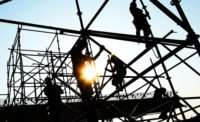Scope:
ANSI/ISEA 121-2018 is a standard that consists of design, testing, performance and labeling requirements for tool tethering systems and containers used to transport and secure tools and equipment at heights.
History:
The American National Standards Institute (ANSI) adopted 121, which was developed by the International Safety Equipment Association (ISEA), a group that represents manufacturers of safety equipment.
This standard was prepared by members of ISEA’s Dropped Objects working group with the following companies as members at the time of the approval of the standard: 3M Company, Ergodyne,
Guardian Fall Protection, Hammerhead Industries, Ty-Flot and West Coast Corporation.
Voluntary consensus standards for safety products are the formalization of requirements for equipment, giving manufacturers’ guidelines for designing and testing product. These often become a way for end users to set a best practice on the job for what safety products to use.
Definitions:
A dropped object can be:
- An object that falls from a height by its own weight and gravity, or
- An object that falls from a height due to contact with an energy source.
According to Dropped Object Prevention Scheme (DROPS), an object that weighs less than three pounds if dropped from a height of 30 feet can be fatal.
DROPS classifies the consequences of a dropped object in the following manner:
Light: A First Aid Case. No injury, or the injury is limited. First aid may be the only treatment needed.
Minor: A Recordable Incident. A work-related injury that does not involve death, day(s) away from work, restricted work or job transfer, and where the employee receives medical treatment beyond first aid.
Major: A Lost Time Incident (LTI). This is a nonfatal traumatic injury that causes any loss of time from work beyond the day or shift it occurred. A major incident is also referred to as Day Away From Work Case (DAFWC).
Fatality: Death resulting from an injury or trauma.
Requirements:
The requirements of this standard will create formal distinction of a proper tethering system compared to duct tape and string and other inferior solutions. ANSI/ISEA 121 is to dropped object prevention equipment what ANSI Z359 is to fall protection equipment.
This standard DOES NOT specify proper use of this equipment for workers or specify what needs to be tethered and when it needs to be tethered.
- Proper use of the equipment is specified by the manufacturer.
- When a worker needs to tether and what they need to tether is specified by a company or a regulatory body.
OSHA does require employers to address falling/dropped objects hazards on the job. OSHA mentions this both in General Industry (1910.23; 1910.28) and Construction (1926.451; 1926.501;
1926.759) standards. This establishes that OSHA does require mitigation of falling/dropped objects risk.
There is no argument that preventing dropped objects all together is a better practice than hard hats, canopies and ground-based safety zones. The latter can minimize damage and injury of a struck by falling object, but they do not prevent the items from falling in the first place.
ANSI/ISEA 121 formalizes and codifies the above to two points, creating the variables of an equation for OSHA to cite under the General Duty Clause. The equipment (attachments, tethering, containers) in 121 are the solutions to the equation.
Equipment covered by standard:
Anchor attachments: These allow a tool to be tethered to someone or something. They’re also retrofitted attachment points, but to a fixed anchor location (such as a structure) or a worker.
Tool attachments: Defined as any retrofitted attachment points that are fitted to tools or other equipment to enable them to be tethered.
Tool tethers: The tool lanyards that tether the equipment to an anchor point.
Containers: Any container that can be used to transport tools, equipment or parts to and from work areas at height. This can include bags, buckets and pouches.
Benefits:
Struck-by falling objects kill hundreds of individuals each year and injure tens of thousands more. Figures from the Bureau of Labor Statistics show there are over 50,000 “struck by object” incidents every year in the US.
Protective equipment, such as hard hats, have long been available to minimize the effects of struck-by incidents only after an object has fallen. Preventative measures such as netting and toe boards are also a mitigating practice for this this risk, however there are challenges to these solutions and they do not entirely prevent incidents. Active controls utilized to prevent falling objects by tying them off or containing them while at heights are a rapidly growing practice.
FAQs:
Does the standard cover how to tether tools?
The standard is not about how you tether tools. It’s focused on the equipment used for tool tethering.
You need to follow manufacturer guidance on weight limits for tethers, anchor points and harnesses, and make use of their training materials to learn how to safely tether your tools.
ANSI/ISEA 121-2018 also doesn’t specify what tools need to be tethered or when you should tether them.
Does this mean I need to replace my tool tethers?
No. If you’re already using tool tethers there’s no need to replace them immediately. This is a voluntary standard. However, you may want to think about upgrading your tool tethering equipment to ANSI/ISEA 121-2018 compliant tool lanyards as and when they need replacing.
If you don’t have proper tool tethers and are using makeshift tethers like string and duct tape, you should invest in proper tool tethering systems
How can I check if a product is ANSI/ISEA 121-2018 approved?
There is certain information that should be clearly displayed on any tool tethering system that complies with ANSI/ISEA 121-2018.
Look for:
- Manufacturer’s identification (name/trademark)
- Reference to ANSI/ISEA 121
- Product identification
- Serial number
- Maximum load capacity
- Maximum tether length (for anchors or attachments) or the tether length (for tethers).
Access to standard:
ANSI/ISEA 121 – 2018 American National Standard for Dropped Object Prevention Solutions can be purchased at https://webstore.ansi.org,, https://store:asp.org, and https://safetyequipment.org
Sources:
Ergodyne: https://www.ergodyne.com
NLG: https://neverletgo.com/ansi-isea-121-2018/
ISEA: https://safetyequipment.org/standard/ansi-isea-121-2018/
Sponsor:
www.ergodyne.com, 800-225-8238
|
2020 Top Standards Article Index ANSI/ISEA 121- Dropped object prevention solutions NFPA 652 standard on fundamentals of combustible dust OSHA most frequently violated standardsFall protection- General Requirements (1926.501) Hazard Communication (1910.1200) The Control of Hazardous Energy (Lockout/Tagout) 1910.147 Respiratory Protection (1910.134) Powered Industrial Trucks (1910.178) |









